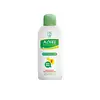What's inside
What's inside
 Key Ingredients
Key Ingredients

 Benefits
Benefits

 Concerns
Concerns

 Ingredients Side-by-side
Ingredients Side-by-side

Water
Skin ConditioningAlcohol
AntimicrobialButylene Glycol
HumectantZinc Oxide
Cosmetic ColorantDisodium Succinate
MaskingSilica
AbrasiveSuccinic Acid
BufferingAloe Barbadensis Leaf Extract
EmollientEthylparaben
PreservativeMethylparaben
PreservativePropylparaben
PreservativeO-Cymen-5-Ol
AntimicrobialDipotassium Glycyrrhizate
HumectantMenthol
MaskingDisodium EDTA
Lactic Acid
BufferingMagnesium Ascorbyl Phosphate
AntioxidantWater
Skin ConditioningButylene Glycol
HumectantPropanediol
Solvent1,2-Hexanediol
Skin ConditioningSalicylic Acid
MaskingCastanea Crenata Shell Extract
Skin ConditioningSodium Hydroxide
BufferingGlycerin
HumectantBiosaccharide Gum-1
HumectantEthylhexylglycerin
Skin ConditioningXanthan Gum
EmulsifyingHydroxyethylcellulose
Emulsion StabilisingDisodium EDTA
Citric Acid
BufferingDipotassium Glycyrrhizate
HumectantHyaluronic Acid
HumectantHydrolyzed Hyaluronic Acid
HumectantSodium Citrate
BufferingSodium Hyaluronate
HumectantSalix Alba Bark Extract
AstringentAllantoin
Skin ConditioningWater, Butylene Glycol, Propanediol, 1,2-Hexanediol, Salicylic Acid, Castanea Crenata Shell Extract, Sodium Hydroxide, Glycerin, Biosaccharide Gum-1, Ethylhexylglycerin, Xanthan Gum, Hydroxyethylcellulose, Disodium EDTA, Citric Acid, Dipotassium Glycyrrhizate, Hyaluronic Acid, Hydrolyzed Hyaluronic Acid, Sodium Citrate, Sodium Hyaluronate, Salix Alba Bark Extract, Allantoin
 Reviews
Reviews

Ingredients Explained
These ingredients are found in both products.
Ingredients higher up in an ingredient list are typically present in a larger amount.
Butylene Glycol (or BG) is used within cosmetic products for a few different reasons:
Overall, Butylene Glycol is a safe and well-rounded ingredient that works well with other ingredients.
Though this ingredient works well with most skin types, some people with sensitive skin may experience a reaction such as allergic rashes, closed comedones, or itchiness.
Learn more about Butylene GlycolDipotassium Glycyrrhizate comes from licorice root.
Extracts of licorice have demonstrated to have antibacterial, anti‐inflammatory, antiviral, antioxidant properties.
One component, glabridin, has extra potent antioxidant and soothing properties. It has also been found to block pigmentation from UVB rays in guinea pigs.
Licorice Root also contains a flavonoid. Flavonoids are a natural substance from in plants. Flavonoids also have antioxidant properties.
Another component, glycyrrhizin, has been found to have anti-inflammatory and antimicrobial benefits. This may make licorice root extract effective at treating acne. However, more research is needed to support this.
Liquiritin is one of the flavone compounds found in licorice. It has been found to help lighten skin by preventing tyrosinase from reacting with tyrosine. When the two react, protein is converted to melanin. Melanin is the substance in your body that gives your features pigmentation.
Licorice root is native to Southern Europe and Asia. It has been used in traditional Chinese medicine to help with respiratory issues.
Learn more about Dipotassium GlycyrrhizateDisodium EDTA plays a role in making products more stable by aiding other preservatives.
It is a chelating agent, meaning it neutralizes metal ions that may be found in a product.
Disodium EDTA is a salt of edetic acid and is found to be safe in cosmetic ingredients.
Learn more about Disodium EDTAWater. It's the most common cosmetic ingredient of all. You'll usually see it at the top of ingredient lists, meaning that it makes up the largest part of the product.
So why is it so popular? Water most often acts as a solvent - this means that it helps dissolve other ingredients into the formulation.
You'll also recognize water as that liquid we all need to stay alive. If you see this, drink a glass of water. Stay hydrated!
Learn more about Water